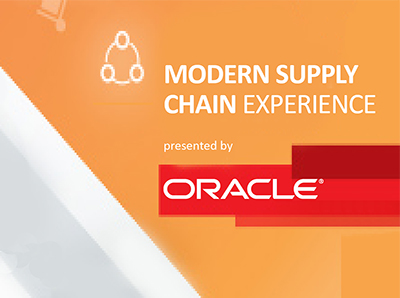As Oracle prepares for its Modern Supply Chain Experience (MSCE) taking place in San Jose, CA from January 29-31, we asked company executives to share a few insights and forecasts surfacing at the event
 According to Roddy Martin, VP of SCM Product Marketing and Albert Chiang, Director of Product Marketing, supply chain managers can expect more disruption of time-consuming processes
According to Roddy Martin, VP of SCM Product Marketing and Albert Chiang, Director of Product Marketing, supply chain managers can expect more disruption of time-consuming processes
“Supply chain is a complex weave of interconnected systems and processes across the business operating model,” he says. “The enterprise architecture in most companies is made up of both transactional and state information and a variety of different applications and systems from specialist vendors.”
According to Martin, the business prioritized end-to-end supply chain crosses multiple boundaries, including physical, financial, operational, and consumer facing processes and has traditionally been focused from supply to the customer. These different systems often operate independently in silos, (for example, logistics, planning, product lifecycle management, and manufacturing), each guided by its own business processes and priorities, own data standards, definitions, products, manufacturing sites, and business goals. For example, many companies struggle with multiple naming and data standards across the product lifecycle – this is a significant barrier as we introduce more digital and analytics into our operating model.
“Often, these are even at odds with each other,” says Martin. “For example, customer service level goals and cost-to-deliver and cost-to-serve, each have tradeoffs if considered together, but can't all be maximized together. Or, different product data standards with contract manufacturers that introduce complexity into contract manufacturer collaboration.“
Martin also notes that in many cases, system and data from different vendors are integrated frequently, in different databases and data warehouses, (and even different organizations and geographies), to operate and use these systems. The problem for the business as it digitizes the operating model, is that there is not one version of the truth.
He adds that the overarching challenge is to find a platform that can keep the end-to-end supply chain business synchronized, and access master data as vendors to change software and processes. This scenario adds complexity and latency to supply chain system, technology, organizational priorities, business goals (like an acquisition), and process integrity:
“The bottom line in this interdependent network of processes, is that a simple delay, (caused by an error or system overload) or disruption, (a supplier failure or product recall), can at any point in this interconnected system, impact customer and business responsiveness in the entire end-to-end system negatively. This therefore can severely impact meeting customer service goals.”
Essentially, says Martin, this boils down to the fact that any point in the traditionally on-premise integrated system, there can be a single point of business failure.
“Machine learning, Blockchain, and IOT can help to reduce and prevent both delays and disruptions by introducing access to new real-time data, new sources, data aggregation, broader visibility, defined processes, and advanced analytics to support a decision,” he says.
Other points made by Martin:
Machine learning (ML), a part of Artificial Intelligence (AI), is already making an impact to supply chain management, by introducing the capabilities that bring historical or predicted insights into descriptive data, extrapolating a future trend to make a prediction – finally, making a prescriptive recommendation to take action.
- For Planning – ML can combine past demand with current social sentiment to gauge what and how much to make and where to put it – making planning demand-driven, instead of supply driven.
- For Manufacturing – managers may preemptively maintain a high-precision injection molding machine before it breaks down or identify symptoms that a high-speed packaging line will fail.
- For Inventory – ML can be used to set an optimum inventory level (especially perishables) that will simultaneously prevent stock outs while reducing excess inventory based on market trends such as weather, demand and promotions.
- For Logistics – ML has the ability to predict the efficiency and effectiveness of local and global traffic to make a recommendation based on cost, time, or quality. The goal being to meet agreed customer service levels.
Blockchain, the underlying technology behind cryptocurrencies such as Bitcoin, is starting to change supply chain as the mental model and requirements for global enterprise-wide tracking and trace abilities change. Blockchain has the potential to bring a new dimension of visibility and traceability to supply chain management – one that can bring ethical, social, and safety changes to supply chain management and global organizations.
Applications of Blockchain to end-to-end supply chains include, for example, the tracking of ethically produced diamonds, critical raw materials, or lifesaving drugs. The overarching goal of this is to reduce the trade of conflict-free diamonds, child labor, counterfeit materials, and illegally sourced raw materials. For example, Blockchain can greatly enhance the safety and integrity of the supply chain by tracking how food is sourced, handled, and transported – and allows grocers and restaurants to individually contact consumers if a questionable lot of raw material was used.
The key is providing the end-to-end visibility of all product, movement, and financial transactions in the product flow from supply to market and the return flow of money.
The Internet of Things (IoT), is the business process and technological capability to have billions of devices broadcasting in real-time into an end-to-end predictive analytics and response system in the supply chain and then respond with appropriate actions based on analytics and insight. The value is to offer business and intelligence insights into planning, business processes, and end-to-end supply chain tradeoffs in as intelligently predictive support as possible.
The reality is that end-to-end supply chain visibility and analytics is one of the biggest performance constraints for most businesses to responsively meet customer service levels. This is the “holy grail “of supply chain” – from industry analysts and our own Oracle experience the problem is the lack of accurate end to end visibility to help businesses make the right decision to meet customer service levels at the right time.
SC
MR


Latest Supply Chain News
- Few executives believe their supply chains can respond quickly to disruptions
- Technology’s role in mending supply chain fragility after recent disruptions
- Tech investments bring revenue increases, survey finds
- Survey reveals strategies for addressing supply chain, logistics labor shortages
- Israel, Ukraine aid package to increase pressure on aerospace and defense supply chains
- More News
Latest Podcast

 Explore
Explore
Topics
Latest Supply Chain News
- Few executives believe their supply chains can respond quickly to disruptions
- Technology’s role in mending supply chain fragility after recent disruptions
- Tech investments bring revenue increases, survey finds
- Survey reveals strategies for addressing supply chain, logistics labor shortages
- Israel, Ukraine aid package to increase pressure on aerospace and defense supply chains
- How CPG brands can deliver on supplier diversity promises
- More latest news
Latest Resources

Subscribe

Supply Chain Management Review delivers the best industry content.

Editors’ Picks





